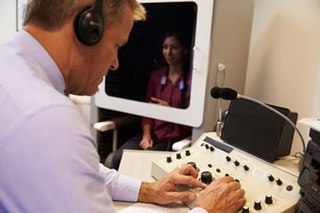
A cochlear implant (CI) is a surgically implanted neuroprosthesis that provides a person who has moderate-to-profound sensorineural hearing loss with sound perception. With the help of therapy, cochlear implants may allow for improved speech understanding in both quiet and noisy environments. A CI bypasses acoustic hearing by direct electrical stimulation of the auditory nerve. Through everyday listening and auditory training, cochlear implants allow both children and adults to learn to interpret those signals as speech and sound.

Audiology is a branch of science that studies hearing, balance, and related disorders. Audiologists treat those with hearing loss and proactively prevent related damage. By employing various testing strategies, audiologists aim to determine whether someone has normal sensitivity to sounds. If hearing loss is identified, audiologists determine which portions of hearing are affected, to what degree, and where the lesion causing the hearing loss is found. If an audiologist determines that a hearing loss or vestibular abnormality is present, they will provide recommendations for interventions or rehabilitation.
Unilateral hearing loss (UHL) is a type of hearing impairment where there is normal hearing in one ear and impaired hearing in the other ear.
Sonova Holding AG is an internationally active Swiss group of companies headquartered in Stäfa that specializes in hearing care. The Sonova group operates through its core business brands Phonak, Unitron, Hansaton, Advanced Bionics, AudioNova and Sennheiser. It is one of the largest providers in the sector worldwide. The group and its brands hold 24% of the global hearing aid market in sales. As of 11 September 2022, Sonova is a component of the Swiss Market Index.
Graeme Milbourne Clark AC is an Australian Professor of Otolaryngology at the University of Melbourne. Worked in ENT surgery, electronics and speech science contributed towards the development of the multiple-channel cochlear implant. His invention was later marketed by Cochlear Limited.

Cochlear is a medical device company that designs, manufactures, and supplies the Nucleus cochlear implant, the Hybrid electro-acoustic implant and the Baha bone conduction implant.
An auditory brainstem implant (ABI) is a surgically implanted electronic device that provides a sense of sound to a person who is profoundly deaf, due to retrocochlear hearing impairment. In Europe, ABIs have been used in children and adults, and in patients with neurofibromatosis type II.
A visual prosthesis, often referred to as a bionic eye, is an experimental visual device intended to restore functional vision in those with partial or total blindness. Many devices have been developed, usually modeled on the cochlear implant or bionic ear devices, a type of neural prosthesis in use since the mid-1980s. The idea of using electrical current to provide sight dates back to the 18th century, discussed by Benjamin Franklin, Tiberius Cavallo, and Charles LeRoy.
Neurostimulation is the purposeful modulation of the nervous system's activity using invasive or non-invasive means. Neurostimulation usually refers to the electromagnetic approaches to neuromodulation.

Henryk Skarzynski is a Polish doctor otolaryngologist, audiologist and phoniatrist, creator and director of Warsaw Institute of Physiology and Pathology of Hearing and World Hearing Center in Kajetany.

Ingeborg J. Hochmair-Desoyer is an Austrian electrical engineer and the CEO and CTO of hearing implant company MED-EL. Dr Hochmair and her husband Prof. Erwin Hochmair co-created the first micro-electronic multi-channel cochlear implant in the world. She received the Lasker-DeBakey Clinical Medical Research Award for her contributions towards the development of the modern cochlear implant. She also received the 2015 Russ Prize for bioengineering.

TheRoyal Victorian Eye and Ear Hospital is a specialist public teaching hospital in East Melbourne, Australia. It is the only hospital in Australia which specialises in both ophthalmology and otolaryngology.

MED-EL is a global medical technology company specializing in hearing implants and devices. They develop and manufacture products including cochlear implants, middle ear implants and bone conduction systems.

Mohan Kameswaran is an Indian otorhinolaryngologist, medical academic and the founder of MERF Institute of Speech and Hearing, a Chennai-based institution providing advanced training in audiology and speech-language pathology. He is one of the pioneers of cochlear implant surgery in India and a visiting professor at Rajah Muthiah Medical College of the Annamalai University and Sri Ramachandra Medical College and Research Institute, Chennai. He has many firsts to his credit such as the performance of the first auditory brain stem implantation surgery in South and South East Asia, the first pediatric brain stem implantation surgery in Asia, the first totally implantable hearing device surgery in Asia Pacific region, and the first to introduce KTP/532 laser-assisted ENT surgery in India. The Government of India awarded him the fourth highest civilian honour of the Padma Shri, in 2006, for his contributions to Indian medicine.
Rylie Green is an Australian biomedical engineer who is a Professor at Imperial College London. She works on bioactive conducting polymers for applications in medical electronics.

Debara Lyn Tucci is an American otolaryngologist, studying ear, nose, and throat conditions. She co-founded the Duke Hearing Center and currently serves as a professor of Surgery and Director of the Cochlear Implant Program at Duke University. In September 2019 she became Director of the National Institute on Deafness and Other Communication Disorders, one of the National Institutes of Health's 27 Institutes and Centers.

Richard Charles Dowell is an Australian audiologist, academic and researcher. He holds the Graeme Clark Chair in Audiology and Speech Science at University of Melbourne. He is a former director of Audiological Services at Royal Victorian Eye and Ear Hospital.
Susan Ellen Shore is an American audiologist who is the Merle Lawrence Collegiate Professor of Otolaryngology at the University of Michigan. She was elected Fellow of the American Association for the Advancement of Science in 2021.
Gerald E. Loeb is an American neurophysiologist, biomedical engineer, academic and author. He is a Professor of Biomedical Engineering, Pharmacy and Neurology at the University of Southern California, the President of Biomed Concepts, and the co-founder of SynTouch.
Colette McKay is an Australian audiologist, academic and researcher. She leads the translational hearing program at the Bionics Institute of Australia.










